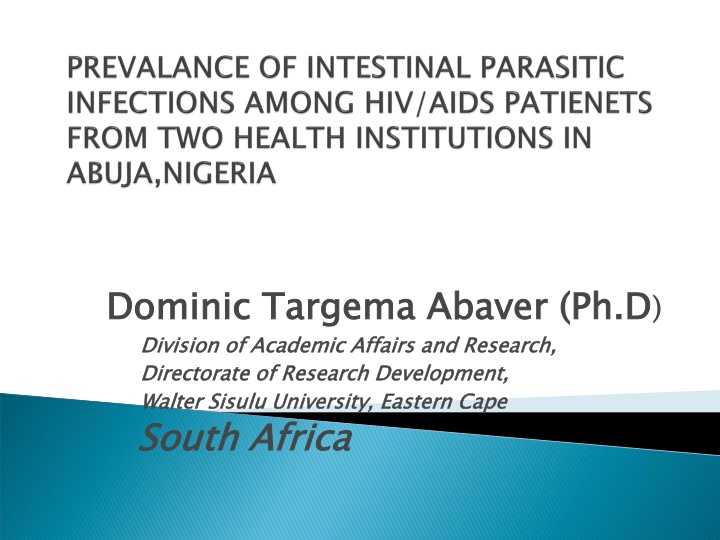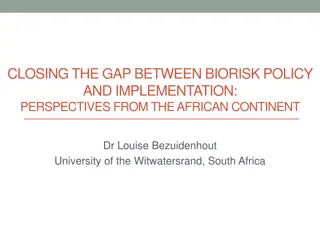
Impact of HIV/AIDS on Intestinal Parasitic Infections
Explore the correlation between HIV/AIDS and intestinal parasitic infections in Sub-Saharan Africa, focusing on the prevalence, implications, and management strategies to enhance public health initiatives. The discussion highlights the challenges faced in combating these infections, underscoring the critical need for early diagnosis and intervention among affected populations.
Download Presentation

Please find below an Image/Link to download the presentation.
The content on the website is provided AS IS for your information and personal use only. It may not be sold, licensed, or shared on other websites without obtaining consent from the author. If you encounter any issues during the download, it is possible that the publisher has removed the file from their server.
You are allowed to download the files provided on this website for personal or commercial use, subject to the condition that they are used lawfully. All files are the property of their respective owners.
The content on the website is provided AS IS for your information and personal use only. It may not be sold, licensed, or shared on other websites without obtaining consent from the author.
E N D
Presentation Transcript
Dominic Targema Abaver (Ph.D Division Directorate Walter South Dominic Targema Abaver (Ph.D) Division of Directorate of Walter Sisulu South Africa of Academic of Research Sisulu University, Africa Academic Affairs Research Development, University, Eastern Affairs and Development, Eastern Cape and Research, Research, Cape
The HIV/AIDS pandemic is a major public health crisis facing the world today An estimated 35.3 (32.2-38.8) million adults and worldwide (WHO, 2013). Sub-Saharan Africa is one of the regions that is hardest hit by this epidemic; with an estimated 22 (20.5-23.6) adults and children living with this virus in this part of the world Nigeria is one of the countries with highest prevalence rate. children are living with the virus
In Nigeria, it was estimated that 2.9-3.3 million people are living with HIV/AIDS at the end of 2005, with about 220, 000 deaths from AIDS and 930, 00 AIDS infants In infections are widely distributed throughout the world, especially, in sub-Saharan Africa. In responsible for 1 million deaths each year. a similar manner, intestinal parasitic this region, these infections are
HIV/AIDS significantly weakens the immunity of the body, opportunistic infections. Lack of safe, portable drinking water, poor hygienic and sanitary conditions are largely responsible for the spread countries. Parasites chronic species Microsporidia Cyclospora and Ascaris Intestinal parasitic infections create a huge concern in the management and care of HIV positive people. rendering it susceptible to various of intestinal parasites in most African frequently diarrhea of spp, Giardia Cyclospora cayetanensis, Ascaris lumbricoides associated HIV with include spp, intestinalis, Entamoeba Blastocystis, Strongiloides, acute and in disease spp, various belli, Cryptosporidium Giardia intestinalis, cayetanensis, Blastocystis, lumbricoides. Cryptosporidium Isospora Entamoeba Strongiloides, Isospora belli, Microsporidia spp,
Detecting these parasites and understanding the status and significance of the infections they cause will treatment of these patients Information on the prevalence of intestinal parasitic infections can help public health bodies to better check further spread within the general population Such data underlie the necessity of early diagnosis and management in order to prevent the health complications among HIV/AIDS patients This study was conducted to examine prevalence of IPI institutions in Abuja, Nigeria greatly help in proper management and among HIV/AIDS patients in two health
It is a cross-sectional study that comprised 119 participants recruited from among the out patients in two health institutions in Nigeria (GEDE AIDS and Infectious Maitama and the Human virology Institute [HVI]- General Hospital Asokoro-Abuja) The mean age of the participants was 29.2 years, ranging from 1-51 years. The proportion of females and males was 50.4% and 49.6% respectively Participants purpose voluntary. They were also assured of anonymity for their laboratory testing, after oral consent was obtained from them Disease Research Institute [GAIDRI], were the briefed study on the participation nature and was of and
Samples were collected between October 2005 and March 2006. Two mls of venous blood was collected by a trained phlebotomist from a total of 119 (94 from consenting participants All blood samples were screened for the purpose of HIV antibodies using the Smart Check HIV . Reactive western blot assay CD4+ counts were determined manually. Values were enumerated only for those with evidence of HIV infection (n=85) Asokoro and 25 from Maitama) from samples were confirmed using the
About 2g of stool samples were collected from all the participants using sterile bottles These were examined macroscopically and microscopically for colour, consistency and presence of ova, larvae, trophozoites and cysts of intestinal parasites After centrifugation, fixed smears were examined under the microscope, taking into consideration, the morphological features in identifying different parasites
The Ethical Committee of the University of Abuja approved the study design and the research Permission for study was obtained from the GAIDRI-Maitama Nigeria; informed consent obtained from all adults(+18years) study participants. Consent permission from below 7years had permission of parents or guardians and HVI-Asokoro Abuja, from <18years parents/guardian-children obtained after
Demographic and other data were analysed using Statistical Package for Social Sciences (SPSS version 17.0; Chicago, USA). Significant differences between categorical variables independent-samples t-test. p-value of <0.05 was considered statistically significant. were determined using the
The over all prevalence rate of enteroparasites obtained in this study was 22.7% (27/119) Of HIV sero positive persons, 21/85 (24.7%) had intestinal parasites Intestinal parasites were also fund in 6/34 (17.6%) of sero negative persons Loose and watery stools were obtained in 21.8% (26/119)
Site Site HIV Number examined HIV seropositi seropositive ve Enteroparasi tes number (%) 10 (14.3%) HIV Number examined HIV seronegati seronegative ve Enteroparasi tes number (%) 2 (8%) Asokoro hospital GAIDRI Total 70 24 15 85 11 (73.3%) 21 (24.7%) 10 34 4 (40%) 6 (17.6%)
Parasites detected were Entamoeba histolytica (6.7%), Hookworm (4.2%), Entamoeba coli (2.5%), Giardia lamblia (2.5%), Hookworm (4.2%), Ascaris lumbricoides (2.5%), Strongyloides stercoralis (2.5%), Trichuris trichura (0.8%), and Taenia spp. (0.8%) Four parasites; Entamoeba coli, G. lamblia, S. stercoralis and T. trichura were detected only in HIV sero positive individuals The most prevalent parasite detected in HIV/AIDS patients, in this study, is E. histolytica (6.7%)
HIV infected (n=85) 6 3 1 3 3 3 1 1 21 HIV infected (n=85) HIV negative (n=34) 2 2 2 0 0 0 0 0 6 HIV negative (n=34) Total (%) (n=119) Total (%) (n=119) Type of parasite found Type of parasite found 8 (6.7%) 5 (4.2%) 3 (2.5%) 3 (2.5%) 3 (2.5%) 3 (2.5%) 1 (0.8%) 1 (0.8%) 27 (22.7%) Entamoeba histolytica Hookworm Ascaris lumbricoides Entamoeba coli Giardia lamblia Strongyloides stercoralis Trichuris trichura Taenia spp. Total number of parasites 95% Cl=0.976-0.670, p=0.576
Intestinal Parasitic Infections have enormous consequences on the health of HIV/AIDs patients Sub-Saharan Africa is already over burdened by HIV infection, and chronic diarrhoea due to intestinal infection is also common in this region Several species of protozoa and other intestinal parasites have been associated with acute and chronic diarrhoea, and even weight loss in HIV/AIDS patients
Of HIV sero positive persons, 21/85 (24.7%) had intestinal parasitic infection as well as of 6/34 (17.6%) sero negative individuals However, this difference is not statistically significant (p>0.05)
The high prevalent rate of E. histolytica (6.7%) fund in HIV/AIDS in this study agrees with the findings of Udeh et al., (2008) where the highest prevalence obtained for this parasite in Abuja was 36.79% Infection with E. histolytica leads to amoebic dysentery; this explains the presence of diarrhoea among most of the HIV/AIDS persons infected with the parasite
The higher rate of this parasite in Abuja metropolis may not be unconnected with the geographical location of Abuja, which is in the tropical region. Survival of ova of most intestinal helminthes and guaranteed in the tropical environment cysts of protozoan is favorably
These parasites have been reported among HIV/AIDS patients in Sub-Saharan African countries. In 2008, Mariam et al. found 11.5% of S. stercoralis in HIV/AIDS in Ethiopia Studies have also reported the presence of intestinal parasites in HIV/AIDS patients in other parts of Nigeria (Okodua et al., 2003; Olusegun, Okaka & Machado, 2009; Adesiji et al., 2005). This could be due to poor hygienic and sanitary conditions; and lack of portable drinking water in most communities. Providing portable drinking water, adequate health education on hygienic practices and sanitary facilities for the Nigerian population could help in curbing this problem.
The various intestinal parasites in among HIV- infected patients in Nigeria The results obtained in this study could provide vital information on various types of intestinal HIV/AIDS relevance patients study highlighted the presence of parasites patients in circulating Abuja, management among their these in hence of the
Mariam ZT, Abebe G, Mulu A. Opportunistic and other intestinal parasitic infections in AIDS patients, HIV seropositive healthy carriers and HIV seronegative individuals in Southwest Ethiopia. East Afr J Public Health 2008;5:3. Silva CV, Ferreira MS, Borges AS, Costa-Cruz JM. Intestinal parasitic infections in HIV/AIDS patients: experience at a teaching hospital in central Brazil. Scand J Infect Dis 2005;37:211-215. Olusegun AF, Okaka CE, Machado RLD. Isosporiasis in HIV/AIDs patients in Edo state Nigeria. Mal J Med Sci 2009;16:3. Adesiji Cryptosporidiasis in HIV infected patients with diarrhoea in Osun YO, Lawal RO, Taiwo SS, Fayemiwo SA, Adeyeba OA. Federal Ministry of Health (FMOH). National HIV/syphilis sero-prevalence sentinel Technical report. FMOH Abuja; 2005. survey among pregnant women attending antenatal clinics.
Okodua M, Adeyeba AO, Tarfeng YM, Okpala HO. Age and sex distribution in parasites infections among HIV-infected subjects in Abeokuta, Nigeria. Online J. Health Allied Sci. 2003 Udeh EO , Goselle ON, Popova D, Abelau M, Popov TV, Jean N, David JS. The prevalence of intestinal protozoans in HIV/AIDS patients in Abuja, Nigeria. Science world J. 2008; 3(3):1-4 GLOBALEMED, LLD. 1101King street , suite 370 Alexandria, VA 22314- 299 Awogun IA. The prevalence of parasitic infections in children living in Ilorin, Kwara State, Nigeria. West Afr. J. Med. 1984; 4(1):16-21 UNAIDS/WHO AIDS epidemic update. Geneva, Switzerland, 2008 UNAID/WHO report on the global AIDS epidemic, Geneva, Switzerland, 2006
WHO Expert committee. Prevention and control of schistosomiasis and soil transmitted helminthiasis. WHO technical report series. 2002; 912:1-57 Schmidt RE. Monoclonal Antibodies for diagnosis of immunodeficiencies. Ann. Haematol.






















